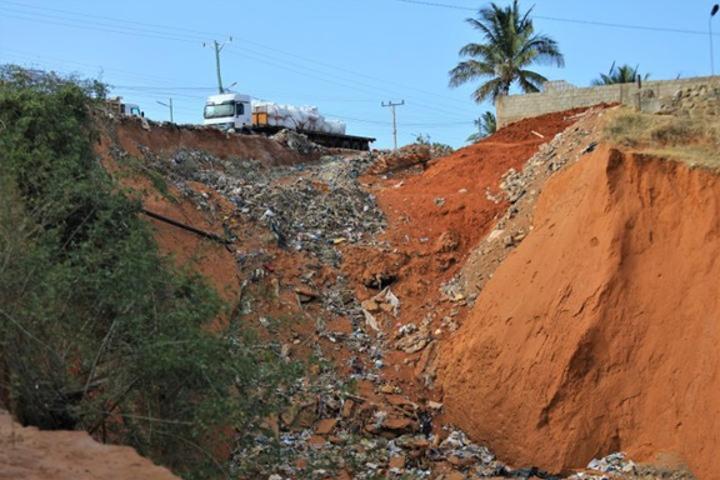Africa-Press – Mozambique. In the Mahate neighbourhood, on the outskirts of Pemba, dozens of families displaced by the terrorist attacks in Cabo Delgado, northern Mozambique, are experiencing a new drama: a gigantic 500-metre ditch grows every year, swallowing up their homes.
“Since we can’t afford it, we’re living like this, says Sofia Gabriel Mussa, 36, who lives in that neighbourhood, next to the National Road 1 (N1), which the gigantic ditch, 50 metres deep and half a kilometre long, is also threatening, just two metres from the tarmac, driving the water into the city bay every time it rains, pushing the houses further apart.
“We’re asking for help, for this pit to recover, for support to help us (…). Put stones, make a ditch, so that the water can go there, to the beach. It’s the help that the whole population is asking for,” she says.
A peasant farmer with seven children, the youngest aged three months, Sofia left Macomia for Pemba, the provincial capital, after an attack by alleged terrorists on her village three years ago. On the day she fled the armed rebels, she saw her brother beheaded by the attackers as he was harvesting rice in the field.
“War problem. They attacked, they came in. They killed, and a lot of people are here,” she laments.
When he arrived in the neighbourhood, the ditch was “small, but it hasn’t stopped growing, especially since 2023, and it also threatens the construction site of a company next to the houses, which is trying to make interventions, at its own cost and on a one-off basis, to contain the advance.
“Yes, we’re very scared, because many houses are suffering. Children are suffering. Last year a child collapsed and we found him down there, passed out,” he recalls, assuming that when it rains – the rainy season runs from October to April – the pit gets bigger”.
The National Roads Administration (ANE) has previously said that it needs 100 million meticais (€1.3 million) to contain the advance of the crater, which threatens to isolate the city of Pemba if it cuts off traffic on the N1.
The problem, and its resolution, involves local authorities, public organisations and Mozambique’s government. The governor of Cabo Delgado province recognises the financial difficulties of a major intervention at the site, but said to Lusa that before the next rainy season, the problem will be minimised.
“In good time and before the rains. We’re working on it, we can’t go any further than that,” said Valige Tauabo.
The authorities plan to use stones to contain the erosion, which is also threatening to destroy an undetermined number of houses in the surrounding area.
Until then, Sofia will wait for something to give her security.
“There was a house here, there was a house there, it’s gone now. Down there too,” she says, pointing to the empty space, dozens of metres deep, that separates the neighbourhood from the road, lamenting the lack of solutions from the authorities, despite her insistence, or she wouldn’t have been chosen as the “head” of ten houses in the neighbourhood.
Even so, she would rather risk living with a crack that continues to grow than return to Macomia with her children and husband: “I have lots of small children and that’s why I’m scared.
A drama that Samuel Matias Tomás, a 19-year-old student, knows well. In 2017, while still a child, he left Mocímboa da Praia after the terrorist attack that, among hundreds of victims, also took his brother.
In 2024, together with his family, including parents and siblings, totalling 11 people, he built a house in that neighbourhood, but soon found himself risking his life.
In rainy weather, there’s a lot of water; many houses have been lost here, they’ve fallen down. We’re asking for help, he says, asking for at least a ditch to drain the water.
“Many people have lost their lives here (…) I’m very scared, he says.
Leaving the neighbourhood is not on the table simply because there is nowhere else to go.
“We have no way of leaving, we have nothing, he says, adding that going back to Mocímboa da Praia is out of the question: “I’m afraid, I’m afraid. I don’t know when I’m going back there.
On the other hand, he sees the crack and is calling for something to be done about it.
“It’s getting bigger. In the rainy season, the water flows more, and we’re losing the land,” he added.
Anifa Sufo, 22, also fled the attacks to Pemba and has been in the neighbourhood for a year, along with her husband and three children.
As she watches the children play, improvising slides through the crevice, she acknowledges her fears.
“We’re scared of that pit. Of someone falling in, even the children,” she points out, asking for something to be done quickly”, such as an embankment or placing stones to provide support.
Otherwise, “it will get worse when this year’s rains start to fall towards the end of the year. Until then, she lets the children play there, but “with fear.
Atimo Ausse Ibraimo, 41, is one of the few who was born in the neighbourhood and recalls that the problem with this crack started “almost 15 years ago. However, everything has been precipitated since 2023, due to the lack of action by the local authorities.
“There were houses here a long time ago, there aren’t any more. And the pit is growing and it’s going to destroy all our houses,” he confesses worriedly, pointing to the other side where he sees his four cousins. In order to be with them, a path that until recently was straightforward now forces him to walk more than 10 minutes down the road to overcome the emptiness of the crevasse.
Not shouting [to the other side]. You can’t hear it, he jokes, while recently counting at least six houses that have gone.
“We’re asking for help, he adds, in a common appeal to all the residents of Mahate, fearful of the approaching rainy season.
For More News And Analysis About Mozambique Follow Africa-Press






